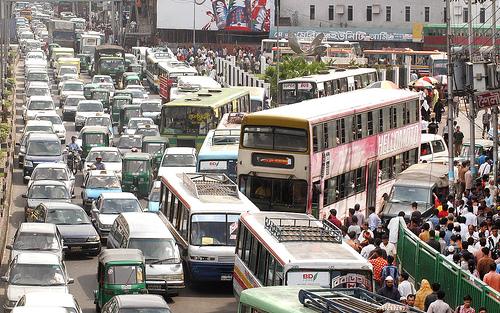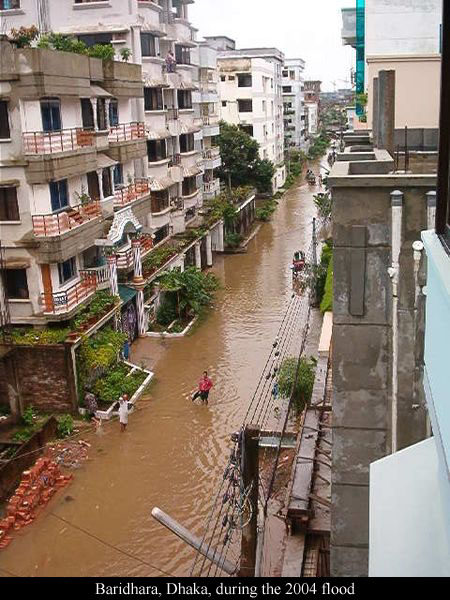Traffic Jam of Dhaka, Bangladesh

I live in Dhaka, only 20 minutes away from my university; but I get out from my house about 1 hour and 15 minutes before class will start. Because of terrible traffic jam, most of the time it takes about an hour to reach university. I remember a week, right after Eid-ul-Fitr Dhaka city was like half empty, at that week I went to university in 20 minutes.
Dhaka is a mega city. More than twelve million people live here. Day by day the number is increasing and most part of Dhaka is badly affected by the population growth. More than 7 hundred thousand rickshaws ply the city road, but only 75 thousand have legal number. This huge number of rickshaws is creating traffic jam. From time to time attempts are made to reduce the number, but the initiative usually produces no results. The number of rickshaw pullers is huge. Almost there are no roads or street or lane free from traffic jam. (more…)
Floods In Bangladesh

Photo: Raiyan Kamai
Baridhara is a zone designated for diplomats, high ranking civil and military officials, and politicians in Dhaka, Bangladesh. Most embassies are located in Baridhara and people works in embassies (foreigners) lives here. It is an affluent part of Bangladesh which is evident by local infrastructures. It is also the location of the American International School of Dhaka (most expensive school in Bangladesh).
Bangladesh, which has 156 million people (July 2009 est.) and the area is 144,000 sq km including 10,090 sq km of water, so the total land is 133,910 sq km. Bangladesh is one of the most vulnerable places to climate change. As the sea level slowly rises, this nation that is little more than a series of low-lying delta islands amid some of Asia’s mightiest rivers – the Ganges, Jamuna-Brahmaputra and Meghna. Bangladesh has more than 150 rivers cross Bangladesh and almost all rivers flows close to the danger marks during flood time. Experts said that major rivers like Jamuna and Padma could overflow at anytime if heavy rainfall occurs and continues for a week. (more…)
The Arctic Ice Cap
The Arctic ice cap shrank so much that waves briefly lapped along two long-imagined Arctic shipping routes, the Northwest Passage over Canada and the Northern Sea Route over Russia. Complicating the picture, the striking Arctic change was as much a result of ice moving as melting.


A host of Arctic scientists say it is too soon to know if the global greenhouse effect has already tipped the system to a condition in which sea ice in summers will be routinely limited to a few clotted passageways in northern Canada.


As we move along with those pictures we can see the Arctic ice caps are melting but very fast. In 2005 the scenario was much worst.

All those pictures were taken on September 16th each year, which is right after the summer. Summer 2007 shows a record breaking loss of arctic sea ice. Experts attribute the changes to the interaction of wid. Weather, ice drift, ocean current and greenhouse gases. (more…)
Global Warming
Global Warming is an environmental issue that is continuing to harm our planet. The definition of Global Warming is “the increase in the average temperature of the Earth’s near-surface air and oceans since the mid-20th century and its projected continuation” (Wikipedia). Therefore, if in the winter snow melts faster than it snows then there has to be something wrong with Earth because average temperature for many years that change one year? The answer is Global Warming. All of sudden icebergs started to melt in Antarctica, North Pole, Greenland and Alaska because of Global Warming. “If we could see with our own eyes how fast the icebergs are malting and hear the sound cracking and crashing of icebergs one into another, we would realize better, what we are doing to our own planet” (An inconvenient truth).
“It is now clear that we face a deepening global climate crisis that requires us to act boldly, quickly and wisely” said Al Gore.
Population and Environment
World population is increasing day by day and our environment is changing day by day. We are changing our living style to eating habit. This video is a great example of it.
This video was made in fall 2006, University of Oregon, Geography Department.
63 comments